World Culinary Heritage
From among the many various traditions on Unesco's lists of Intangible Cultural Heritage I've picked those which I deemed to be culinary in nature. They include entries related to particular dishes or beverages, ritual meals or even entire cuisines and dietary traditions. I have omitted those entries which are primarily related to traditional methods of producing raw food materials (agricultural, pastoral, hunting, foraging, fishing, beekeeping, etc.). I will be updating the table as more traditional practices are inscribed by Unesco.
Only those countries which are party to the Convention for the Safeguarding of the Intangible Cultural Heritage can submit their entries to the lists. Countries which never accepted the convention include Australia, Canada, Israel, Russia, South Africa and the United States.
| Tradition | Nominating countries | Year of inscription | Image |
|---|---|---|---|
| Al-man’ouché🔊 – Lebanese equivalent of pizza, a breakfast flatbread spread with olive oil and sprinkled with salt, thyme, sumac and sesame seeds | 2023 | 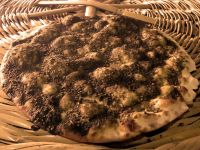
| |
| Asturian cider | 2024 | 
| |
| Attieké🔊 – porridge made of cassava tubers and served as a side dish in Ivory Coast | 2024 | 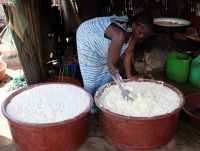
| |
| Baguette (see also: Is Poolish Polish?) |
2022 | 
| |
| Belgian beer | 2016 | 
| |
| Cassava bread made in the Carribean Basin | 2024 | 
| |
| Ceebu jën🔊 – a Senegalese dish of rice, fish and vegetables (see also: A Fried Pie and a Fish Dish) |
2021 | 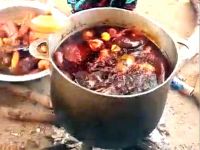
| |
| Ceviche🔊 – an appetizer made from raw fish marinated in citrus juice mixed with salt, onion and chili peppers, typical for the Pacific coast of South and Central Americas | 2023 | 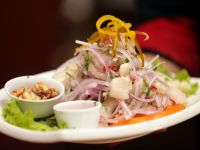
| |
| Chinese New Year, celebrated in spring by having a ceremonial dinner, including various foods whose names in Chinese are associated with good fortune. A fish dish is eaten only in part with some left over for the following day, which is believed to bring good luck in the coming year. | 2024 | 
| |
| Coffee in the Arabic style (see also: Tea or Coffee?) |
2015 | 
| |
| Coffee in the Turkish style (see also: Tea or Coffee?) |
2013 | 
| |
| Couscous – durum-wheat semolina porridge made in the Maghreb | 2020 | 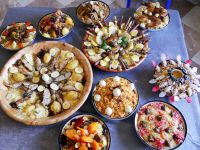
| |
| Cuban light rum | 2022 | 
| |
| Dolma – stuffed vine leaves and vegetables | 2017 | 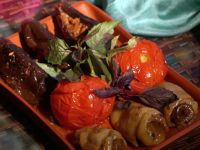
| |
| Dragon Boat Festival, observed in China to commemorate the poet Qū Yuán🔊 (4th/3rd centuries BCE) who killed himself by drowning in a river when his city was invaded by a foreign army. The festival involves eating zongzi,🔊 or tetrahedral sticky-rice dumplings with meat or sweet filling that are wrapped in bamboo leaves and boiled, as well as drinking xiónghuáng jiǔ,🔊 rice or millet wine with powdered realgar (a red mineral consisting mostly of arsenic sulfide). | 2009 | 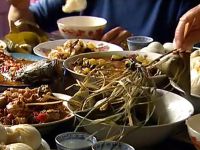
| |
| Ftira – Maltese sourdough flatbread | 2020 | 
| |
| Gastronomic meal of the French – the French way of celebrating special occasions by enjoying good food and drink together | 2010 | 
| |
| Gingerbreads of northern Croatia | 2010 | 
| |
| Harees (in Arabic; not to be confused with harissa) or keşkek (in Turkish) – porridge of wheat or barley cracked with a wooden mallet and mixed with meat and clarified butter, often prepared in large quantities and in a ceremonial manner with live music for special occasions, especially pilgrimages and Ramadan. Known in a vast area from Turkey and Armenia, to the Arabian Peninsula, to eastern Africa. Arabs typically eat it with their fingers while sitting on one knee. | 2011 | 
| |
| 2023 | |||
| Harissa – chili-pepper paste made in the Maghreb. Not to be confused with harees. | 2022 | 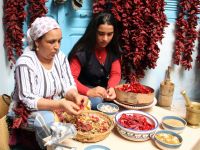
| |
| Hawker culture of Singapore, combining Chinese, Malay, Indian and European culinary traditions | 2020 | 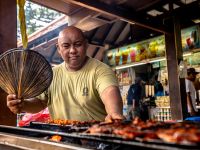
| |
| Iftar – a ceremonial supper, often shared by large numbers of people, eaten by Muslims after a whole day of fasting during Ramadan | 2023 | 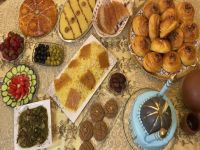
| |
| Jang🔊 – Korean condiment made from fermented soy beans and hot peppers | 2024 | 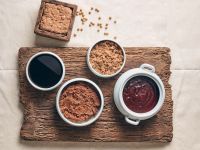
| |
| Kimjang🔊 – the Korean art of making kimchi,🔊 or spicy vegetable and seafood pickles | 2013 | 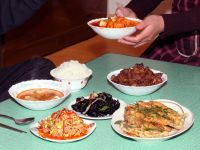
| |
| 2015 | |||
| Krakelingen – ring-shaped pretzels which at the end of the carnival are tossed from a hill to the people of the Flemish town of Geraardsbergen by members of the municipal authorities who first have to drink a goblet of wine together with a live roach swimming in it (see also: Holey Breads) |
2010 | 
| |
| Kumis (in Kazakh) or airag (in Mongolian) – an alcoholic drink made from mare's milk by horse herders in the steppes of central Asia | 2018 | 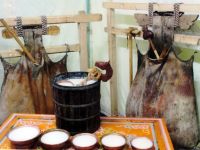
| |
| 2019 | |||
| Lavash, also know as katyrma or yufka – unleavened flatbread commonly baked in western and central Asia | 2014 | 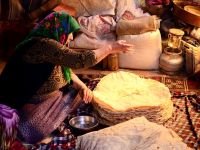
| |
| 2016 | |||
| Malaysian breakfast, consisting of: nasi lemak🔊 (rice cooked in coconut milk and flavoured with pandan leaved, usually wrapped in banana leaves and served with hot sauce, fresh cucumber, fried anchovies, roasted peanuts and hard-boiled egg), roti canai 🔊 (fried flatbread), saté🔊 (skewered meat) and teh tarik🔊 (frothy black tea with condensed milk) | 2024 | 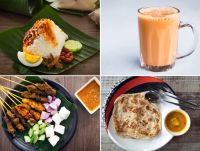
| |
| Mansaf – Levantine dish of lamb or kid cooked in ewe's or goat's milk yogurt, served with bulgur or rice and very thin unleavened flatbread | 2022 | 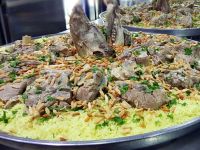
| |
| Mediterranean diet | 2010 | 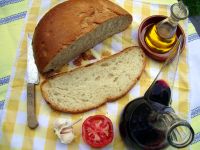
| |
| Mesir macunu – candies made of toffee mixed with 41 kinds of herbs and spices, which around the spring equinox are distributed from the roofs and minarets of Sultan's Mosque in Magnesia (Manisa) on Turkey's Aegean coast to commemorate a legend about the herbal paste bringing Sultan Suleiman the Magnificent's mother back to health | 2012 | 
| |
| Messosporitissa,🔊 the Festivity of the Entry of the Most Holy Mother of God into the Temple, or Our Lady of the Mid-Sowing Season (21 November), celebrated especially in Eleusis by blessing various foods, such as: soup of various cereals and legumes, two kinds of bread, olive oil and wine | 2024 | 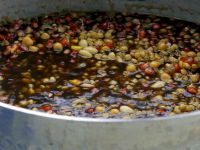
| |
| Mexican cuisine, making use of such native foods as: maize, tomato, Capsicum pepper, pumpkin, avocado, cocoa and vanilla, as well as traditional practices, such as nixtamalization, or cooking maize in limewater | 2010 | 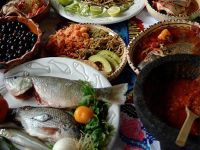
| |
| Mulgi puder🔊 – Mush of mashed potatoes and barley, served with pork cracklings and fried onion, typical for the Mulgimaa region of southern Estonia | 2024 | 
| |
| Nowruz – Persian New Year observed on spring equinox by consuming a ceremonial meal among other celebrations | 2016 | 
| |
| Nsima – East African maize-flour porridge | 2017 | 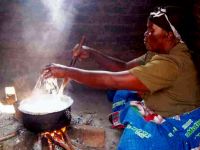
| |
| Oku-noto no Aenokoto – a ritual celebrated twice a year by the farmers of Noto Peninsula in Japan, in which a deity of the rice paddy is invited into one's house for a sacrificial meal consisting mostly of rice, beans and fish | 2009 | 
| |
| Oshitushi shomagongo – a festival celebrating the harvest of the wild-growing marula fruits which the Owambo people of northern Namibia use for making wine called omagongo | 2015 | 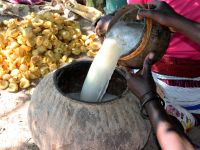
| |
| Pilaf, also known as palav (in Tajik) or palov (in Uzbek) – a dish made of rice, meat and vegetables, commonly made in western and central Asia | 2016 | 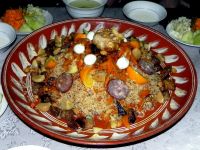
| |
| 2016 | |||
| Pizza napoletana, or Naples-style pizza | 2017 | 
| |
| Queijo-de-minas🔊 – traditional cow's cheese from the state of Minas Gerais | 2024 | 
| |
| Qvevri – huge ceramic amphorae which Georgians (the Eurasian, not the American ones) fill with wine and bury in the ground for the wine to age | 2013 | 
| |
| Raengmyon – cold soup with buckwheat noodles, meat, vegetables and eggs that is traditionally eaten in Pyongyang | 2022 | 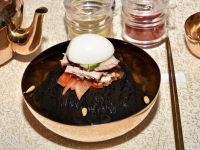
| |
| Saké🔊 – Japanese alcoholic beverage made from rice fermented with kōji 🔊 mould | 2024 | 
| |
| Slava – day of a family's patron saint celebrated with a festive meal and a round yeast cake called slavski kolač | 2014 | 
| |
| Šljivovica – Serbian plum brandy | 2022 | 
| |
| Soupe joumou – soup made from turban squash (the giraumon variety) with plantains (green bananas) and other vegetables, beef and spices, consumed especially on Haitian Independence Day (1 January) | 2021 | 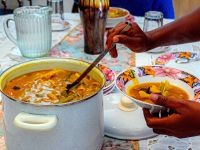
| |
| Tandir – a clay oven used pimarily (though not only) for baking flat yeast breads | 2024 | 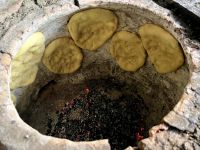
| |
| Tea in the Chinese style (see also: Tea or Coffee?) |
2022 | 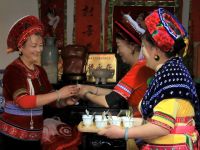
| |
| Tea in the Turkish style (see also: Tea or Coffee?) |
2022 | 
| |
| Tom yum kung🔊 – Central Thai sour-and-hot soup with lemongrass, lime, kaffir leaves, galangal, shallots, hot peppers and freshwater prawns | 2024 | 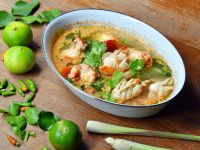
| |
| Ukrainian borscht ⚠️ Inscribed on the list of Intangible Heritage in Need of Urgent Safeguarding. |
2022 | 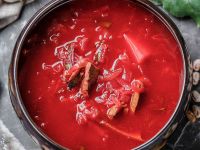
| |
| Washoku – traditional Japanese cuisine typically seen during New Year celebrations | 2013 | 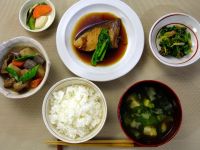
| |
| Xeedho – a decorative vessel or basket filled with camel or beef jerky and, in ethnic Somali tradition, given as a wedding present from the mother-in-law to the bridegroom. ⚠️ Inscribed on the list of Intangible Heritage in Need of Urgent Safeguarding. |
2023 | 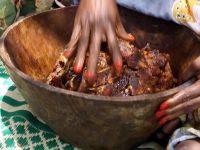
| |
| Yaldā – ritual supper consumed in the lands of the former Persian Empire on the night of winter solstice, in which red fruits (pomegranates, watermelons, grapes, jujube) are especially prominent | 2022 | 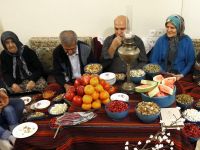
|